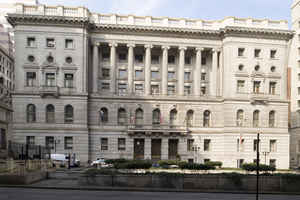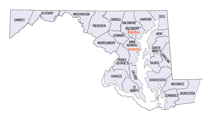Maryland Counties
There are twenty-four counties and county-equivalents in Maryland. Though an independent city rather than a county, the City of Baltimore is considered the equal of a county. The last new county formation in Maryland occurred when Garrett County was formed in 1872 from portions of Allegany County.Baltimore City , Maryland
Baltimore City History, Geography, and Demographics
Baltimore is the largest city in the state of Maryland, and the 26th-most populous city in the country. It is the largest independent
city in the United States.
Founded in 1729, Baltimore is the second largest seaport in the Mid-Atlantic. Baltimore's Inner Harbor was once the second leading port of
entry for immigrants to the United States and a major manufacturing center. After a decline in major manufacturing, industrialization and rail
transportation, Baltimore shifted to a service-oriented economy, with the Johns Hopkins Hospital (founded 1889), and Johns Hopkins University
(founded 1876), now the city's top two employers
Baltimore had a population of 622,104 in 2013; in 2010, that of Baltimore Metropolitan Area was 2.7 million, the 20th largest in the country.
Etymology - Origin of Baltimore City Name
The city is named after Cecil Calvert, second Lord Baltimore, (1605-1675), a member of the Irish House of Lords and the founding proprietor of the Colony and Province of Maryland. Baltimore is an anglicization of the Irish name Baile an Tí Mhoir, meaning "town of the big house", which was the name of the estate in County Longford on which the Calvert family lived, in Ireland
Demographics:
County QuickFacts: CensusBureau Quick Facts
Baltimore City History
Baltimore is an independent city and the largest city in the state of Maryland in the United States. Founded in 1729. Detached in 1851 from Baltimore County
The colonial General Assembly of Maryland created the Port of Baltimore at old Whetstone Point (now Locust Point) in 1706 for the tobacco trade. The Town of Baltimore was founded and laid out shortly thereafter on July 30, 1729, and is named after Lord Baltimore (Cecilius Calvert), who was the first Proprietary Governor of the Province of Maryland. Cecilius Calvert was the oldest son of Sir George Calvert, (1579-1632), who became the First Lord Baltimore of County Longford, Ireland in 1625. Previously, he had been a loyal agent of King Charles I of England (1600-1649) as his Secretary of State until declaring himself a follower of Roman Catholicism. Regardless, the King still gave his heir Cecil the 1632 grant for the Maryland colony. The colony was a followup to his earlier settlement in Newfoundland, known as "Acadia" or "Avalon", (future Canada), which he found too cold and difficult for habitation.
Geography: Land and Water
Baltimore is in north-central Maryland on the Patapsco River close to where it empties into the Chesapeake Bay.
The city is also located on the fall line between the Piedmont Plateau and the Atlantic Coastal Plain, which divides
Baltimore into "lower city" and "upper city". The city's elevation ranges from sea level at the harbor to 480 feet
(150 m) in the northwest corner near Pimlico.
As reported by the Census Bureau, the city has a total area of 92.1 square miles (238.5 km2), of which, 80.8
square miles (209.3 km2) of it is land and 11.3 square miles (29.2 km2) of it is water. The total area is 12.24
percent water.
Neighboring Counties
Bordering counties are as follows:
The City of Baltimore is bordered by the following communities, all unincorporated census-designated places. All are in adjacent Baltimore County, except Brooklyn Park and Glen Burnie, which are in adjacent Anne Arundel County. In addition, the southern part of the city is bordered by another unincorporated part of northeastern Anne Arundel County.
- Arbutus
- Brooklyn Park
- Catonsville
- Dundalk
- Glen Burnie
- Lansdowne-Baltimore Highlands
- Lochearn
- Overlea
- Parkville
- Pikesville
- Rosedale
- Towson
- Woodlawn
Education
Colleges and universities
Baltimore is the home of numerous places of higher learning, both public and private. More than 66,000 students attend Baltimore City's 12
accredited two-year or four-year colleges and universities. Among them are:
Private
Keyser Quadrangle in Spring at the Johns Hopkins University
The Johns Hopkins University
Baltimore International College
Loyola University Maryland
Maryland Institute College of Art
St. Mary's Seminary and University
Notre Dame of Maryland University
The Peabody Institute of Johns Hopkins University
Sojourner-Douglass College
Public
Baltimore City Community College
Coppin State University
Morgan State University
Towson University
University of Baltimore
University of Maryland, Baltimore County
University of Maryland, Baltimore
Primary and secondary schools
The city's public schools are managed by Baltimore City Public Schools







